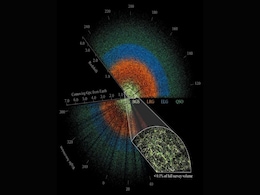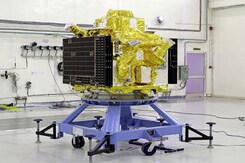Astronomy
- All
- News
- Videos
- Web Stories
-

Solar Eclipse 2025: Best Viewing Locations, Safety Tips And How To Watch
- Friday March 28, 2025
- Science | Edited by Bhavya Sukheja
Skywatchers and astronomy enthusiasts are in for a spectacular celestial event as a partial solar eclipse is set to take place on March 29, Saturday.
-
 www.ndtv.com
www.ndtv.com
-

Solar Eclipse March 29: Google Launches Special Animation
- Wednesday March 26, 2025
- Offbeat | Edited by Nikhil Pandey
Google is celebrating the upcoming March 29, 2025, total solar eclipse with a special animation that appears when users search for relevant terms, visually depicting the event and showcasing the sun's corona.
-
 www.ndtv.com
www.ndtv.com
-

New Research Suggests Dark Energy Is Evolving, Challenging Cosmology Models
- Wednesday March 26, 2025
- Written by Gadgets 360 Staff
New research from the DESI project suggests that dark energy, once thought to be a constant force, may actually be changing over time. This challenges long-held cosmological models that assume a stable influence of dark energy on the universe’s expansion. By mapping 15 million galaxies, DESI’s data raises new questions about cosmic evolution. S...
-
 www.gadgets360.com
www.gadgets360.com
-

Supernova Remnants Found in Oceanic Samples, Scientists Look to Moon
- Wednesday March 26, 2025
- Written by Gadgets 360 Staff
Scientists have identified supernova debris in deep-sea sediments, including a rare plutonium isotope linked to a kilonova. Researchers believe a neutron star collision occurred nearly 10 million years ago, scattering radioactive material across space. To validate this theory, they plan to analyze lunar soil, which remains undisturbed by Earth's ge...
-
 www.gadgets360.com
www.gadgets360.com
-

Alien Life May Survive on Planets Orbiting White Dwarfs, Study Finds
- Wednesday March 26, 2025
- Written by Gadgets 360 Staff
New research explores the possibility of alien life on planets orbiting white dwarfs. While these stellar remnants cool over time, their shrinking habitable zones may still allow biological processes like photosynthesis and UV-driven abiogenesis to occur. A model assessing a planet's energy reception over seven billion years indicates that life-sus...
-
 www.gadgets360.com
www.gadgets360.com
-

Wolf-Rayet 104's Orbit Tilt Reduces Gamma-Ray Burst Threat, Study Finds
- Thursday March 20, 2025
- Written by Gadgets 360 Staff
New research using Keck Observatory’s instruments confirms that the orbit of Wolf-Rayet 104 is tilted 30-40 degrees away from Earth, lowering concerns about a possible gamma-ray burst. Previously, it was believed that the system’s alignment could pose a risk. However, spectroscopy data now challenges these assumptions, raising new questions abo...
-
 www.gadgets360.com
www.gadgets360.com
-

Hubble Telescope Captures NGC 4536, a Starburst Galaxy with Intense Star Formation
- Wednesday March 26, 2025
- Written by Gadgets 360 Staff
NASA’s Hubble Space Telescope has captured a striking image of NGC 4536, a starburst galaxy 50 million light-years away in the Virgo constellation. The galaxy’s sweeping spiral arms are filled with young blue star clusters and ionized hydrogen gas, indicating rapid star formation. Astronomers believe its bar-like structure channels gas toward t...
-
 www.gadgets360.com
www.gadgets360.com
-

James Webb Space Telescope Captures Hourglass Nebula LBN 483 in Stunning Detail
- Tuesday March 18, 2025
- Written by Gadgets 360 Staff
The James Webb Space Telescope has captured unprecedented details of LBN 483, a nebula located 650 light-years away. The striking hourglass-shaped structure results from outflows driven by a forming binary star system. JWST’s infrared imaging and ALMA’s radio observations reveal how stellar winds, jets, and magnetic fields sculpt the nebula ove...
-
 www.gadgets360.com
www.gadgets360.com
-

Smallest Galaxy Ever Found: Andromeda XXXV Defies Cosmic Evolution Models
- Thursday March 13, 2025
- Written by Gadgets 360 Staff
Astronomers have discovered Andromeda XXXV, the smallest and faintest known galaxy, located 3 million light-years away. It challenges existing models of galaxy formation, as similar small galaxies were thought to be destroyed in the early universe. Researchers are studying how it retained conditions for star formation despite harsh cosmic environme...
-
 www.gadgets360.com
www.gadgets360.com
-

SpaceX Falcon 9 Successfully Deploys NASA’s SPHEREx Telescope and PUNCH Probes
- Thursday March 13, 2025
- Written by Gadgets 360 Staff
NASA’s SPHEREx and PUNCH missions have successfully launched aboard a SpaceX Falcon 9 rocket from Vandenberg Space Force Base in California. SPHEREx will map the entire celestial sky in 102 infrared colours, while PUNCH will study the transition of the sun’s corona into the solar wind. The two-year missions aim to deepen our understanding of th...
-
 www.gadgets360.com
www.gadgets360.com
-

Water May Have Formed in the Universe 100 Million Years After Big Bang
- Thursday March 13, 2025
- Written by Gadgets 360 Staff
A new study suggests water formed in the universe just 100–200 million years after the Big Bang, much earlier than previously estimated. Researchers examined ancient supernovas to understand how oxygen combined with hydrogen to create water. If confirmed, these findings could change perspectives on when the conditions for life first emerged. The ...
-
 www.gadgets360.com
www.gadgets360.com
-

Mysterious Planetary-Mass Objects May Form in Young Star System Clashes
- Wednesday March 12, 2025
- Written by Gadgets 360 Staff
Recent research challenges traditional views on planetary-mass objects, suggesting they may form through violent interactions between young star systems rather than standard planetary or stellar processes. Simulations indicate these clashes create dense gas filaments that evolve into free-floating objects, often in binary pairs. This discovery expl...
-
 www.gadgets360.com
www.gadgets360.com
-

New Dark Matter Hypothesis Suggests Ionisation Clue in Milky Way’s Core
- Wednesday March 12, 2025
- Written by Gadgets 360 Staff
Researchers propose that an overlooked dark matter candidate may explain unusual ionisation levels in the Milky Way’s Central Molecular Zone (CMZ). This theory suggests that lightweight, self-annihilating dark matter particles could be producing electrons and positrons, influencing cosmic chemistry. The findings challenge conventional views, offe...
-
 www.gadgets360.com
www.gadgets360.com
-

Hubble Captures Stunning Infrared Image of Sh2-284, a Massive Stellar Nursery
- Wednesday March 12, 2025
- Written by Gadgets 360 Staff
Hubble’s latest image of the massive Sh2-284 nebula reveals young stars concealed within thick clouds of gas and dust. Using infrared imaging, astronomers have captured details previously obscured in optical wavelengths. The nebula’s low-metallicity composition provides a glimpse into the conditions of the early universe, shedding light on how ...
-
 www.gadgets360.com
www.gadgets360.com
-

Solar Eclipse 2025: Best Viewing Locations, Safety Tips And How To Watch
- Friday March 28, 2025
- Science | Edited by Bhavya Sukheja
Skywatchers and astronomy enthusiasts are in for a spectacular celestial event as a partial solar eclipse is set to take place on March 29, Saturday.
-
 www.ndtv.com
www.ndtv.com
-

Solar Eclipse March 29: Google Launches Special Animation
- Wednesday March 26, 2025
- Offbeat | Edited by Nikhil Pandey
Google is celebrating the upcoming March 29, 2025, total solar eclipse with a special animation that appears when users search for relevant terms, visually depicting the event and showcasing the sun's corona.
-
 www.ndtv.com
www.ndtv.com
-

New Research Suggests Dark Energy Is Evolving, Challenging Cosmology Models
- Wednesday March 26, 2025
- Written by Gadgets 360 Staff
New research from the DESI project suggests that dark energy, once thought to be a constant force, may actually be changing over time. This challenges long-held cosmological models that assume a stable influence of dark energy on the universe’s expansion. By mapping 15 million galaxies, DESI’s data raises new questions about cosmic evolution. S...
-
 www.gadgets360.com
www.gadgets360.com
-

Supernova Remnants Found in Oceanic Samples, Scientists Look to Moon
- Wednesday March 26, 2025
- Written by Gadgets 360 Staff
Scientists have identified supernova debris in deep-sea sediments, including a rare plutonium isotope linked to a kilonova. Researchers believe a neutron star collision occurred nearly 10 million years ago, scattering radioactive material across space. To validate this theory, they plan to analyze lunar soil, which remains undisturbed by Earth's ge...
-
 www.gadgets360.com
www.gadgets360.com
-

Alien Life May Survive on Planets Orbiting White Dwarfs, Study Finds
- Wednesday March 26, 2025
- Written by Gadgets 360 Staff
New research explores the possibility of alien life on planets orbiting white dwarfs. While these stellar remnants cool over time, their shrinking habitable zones may still allow biological processes like photosynthesis and UV-driven abiogenesis to occur. A model assessing a planet's energy reception over seven billion years indicates that life-sus...
-
 www.gadgets360.com
www.gadgets360.com
-

Wolf-Rayet 104's Orbit Tilt Reduces Gamma-Ray Burst Threat, Study Finds
- Thursday March 20, 2025
- Written by Gadgets 360 Staff
New research using Keck Observatory’s instruments confirms that the orbit of Wolf-Rayet 104 is tilted 30-40 degrees away from Earth, lowering concerns about a possible gamma-ray burst. Previously, it was believed that the system’s alignment could pose a risk. However, spectroscopy data now challenges these assumptions, raising new questions abo...
-
 www.gadgets360.com
www.gadgets360.com
-

Hubble Telescope Captures NGC 4536, a Starburst Galaxy with Intense Star Formation
- Wednesday March 26, 2025
- Written by Gadgets 360 Staff
NASA’s Hubble Space Telescope has captured a striking image of NGC 4536, a starburst galaxy 50 million light-years away in the Virgo constellation. The galaxy’s sweeping spiral arms are filled with young blue star clusters and ionized hydrogen gas, indicating rapid star formation. Astronomers believe its bar-like structure channels gas toward t...
-
 www.gadgets360.com
www.gadgets360.com
-

James Webb Space Telescope Captures Hourglass Nebula LBN 483 in Stunning Detail
- Tuesday March 18, 2025
- Written by Gadgets 360 Staff
The James Webb Space Telescope has captured unprecedented details of LBN 483, a nebula located 650 light-years away. The striking hourglass-shaped structure results from outflows driven by a forming binary star system. JWST’s infrared imaging and ALMA’s radio observations reveal how stellar winds, jets, and magnetic fields sculpt the nebula ove...
-
 www.gadgets360.com
www.gadgets360.com
-

Smallest Galaxy Ever Found: Andromeda XXXV Defies Cosmic Evolution Models
- Thursday March 13, 2025
- Written by Gadgets 360 Staff
Astronomers have discovered Andromeda XXXV, the smallest and faintest known galaxy, located 3 million light-years away. It challenges existing models of galaxy formation, as similar small galaxies were thought to be destroyed in the early universe. Researchers are studying how it retained conditions for star formation despite harsh cosmic environme...
-
 www.gadgets360.com
www.gadgets360.com
-

SpaceX Falcon 9 Successfully Deploys NASA’s SPHEREx Telescope and PUNCH Probes
- Thursday March 13, 2025
- Written by Gadgets 360 Staff
NASA’s SPHEREx and PUNCH missions have successfully launched aboard a SpaceX Falcon 9 rocket from Vandenberg Space Force Base in California. SPHEREx will map the entire celestial sky in 102 infrared colours, while PUNCH will study the transition of the sun’s corona into the solar wind. The two-year missions aim to deepen our understanding of th...
-
 www.gadgets360.com
www.gadgets360.com
-

Water May Have Formed in the Universe 100 Million Years After Big Bang
- Thursday March 13, 2025
- Written by Gadgets 360 Staff
A new study suggests water formed in the universe just 100–200 million years after the Big Bang, much earlier than previously estimated. Researchers examined ancient supernovas to understand how oxygen combined with hydrogen to create water. If confirmed, these findings could change perspectives on when the conditions for life first emerged. The ...
-
 www.gadgets360.com
www.gadgets360.com
-

Mysterious Planetary-Mass Objects May Form in Young Star System Clashes
- Wednesday March 12, 2025
- Written by Gadgets 360 Staff
Recent research challenges traditional views on planetary-mass objects, suggesting they may form through violent interactions between young star systems rather than standard planetary or stellar processes. Simulations indicate these clashes create dense gas filaments that evolve into free-floating objects, often in binary pairs. This discovery expl...
-
 www.gadgets360.com
www.gadgets360.com
-

New Dark Matter Hypothesis Suggests Ionisation Clue in Milky Way’s Core
- Wednesday March 12, 2025
- Written by Gadgets 360 Staff
Researchers propose that an overlooked dark matter candidate may explain unusual ionisation levels in the Milky Way’s Central Molecular Zone (CMZ). This theory suggests that lightweight, self-annihilating dark matter particles could be producing electrons and positrons, influencing cosmic chemistry. The findings challenge conventional views, offe...
-
 www.gadgets360.com
www.gadgets360.com
-

Hubble Captures Stunning Infrared Image of Sh2-284, a Massive Stellar Nursery
- Wednesday March 12, 2025
- Written by Gadgets 360 Staff
Hubble’s latest image of the massive Sh2-284 nebula reveals young stars concealed within thick clouds of gas and dust. Using infrared imaging, astronomers have captured details previously obscured in optical wavelengths. The nebula’s low-metallicity composition provides a glimpse into the conditions of the early universe, shedding light on how ...
-
 www.gadgets360.com
www.gadgets360.com



































